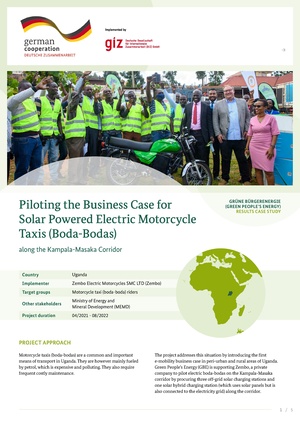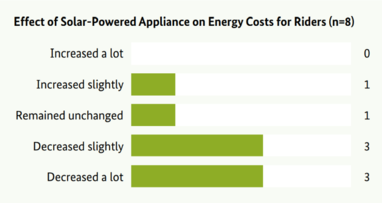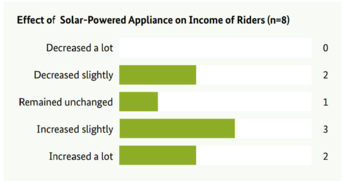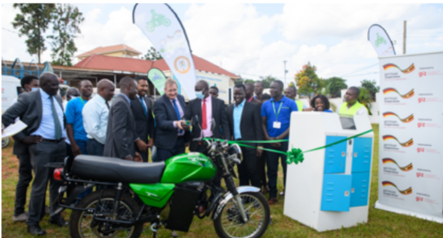Knowledge fuels change - Support energypedia!
For over 10 years, energypedia has been connecting energy experts around the world — helping them share knowledge, learn from each other, and accelerate the global energy transition.
Today, we ask for your support to keep this platform free and accessible to all.
Even a small contribution makes a big difference! If just 10–20% of our 60,000+ monthly visitors donated the equivalent of a cup of coffee — €5 — Energypedia would be fully funded for a whole year.
Is the knowledge you’ve gained through Energypedia this year worth €5 or more?
Your donation keeps the platform running, helps us create new knowledge products, and contributes directly to achieving SDG 7.
Thank you for your support, your donation, big or small, truly matters!
Piloting the Business Case for Solar Powered Electric Motorcycle Taxis (Boda-Bodas) in Uganda
Piloting the Business Case for Solar Powered Electric Motorcycle Taxis (Boda-Bodas) in Uganda
Project Approach
Motorcycle taxis (boda-bodas) are a common and important means of transport in Uganda. They are however mainly fueled by petrol, which is expensive and polluting. They also require frequent costly maintenance. The project addresses this situation by introducing the first e-mobility business case in peri-urban and rural areas of Uganda. Green People’s Energy (GBE) is supporting Zembo, a private company to pilot electric boda-bodas on the Kampala-Masaka corridor by procuring three off-grid solar charging stations and one solar hybrid charging station (which uses solar panels but is also connected to the electricity grid) along the corridor.The corridor was selected after a survey done by Zembo revealed that many of their existing riders come from the areas along the Kampala – Masaka National Highway. It is the longest e-mobility corridor ever launched in Uganda. The project promotes a switch to electric boda-bodas under the new concept of battery swapping in the e-mobility sector. Instead of recharging the batteries of their boda-bodas, riders can replace or swap their depleted battery with a fully charged one at the solar charging stations in less than a minute and at an affordable price. The solar-powered charging stations are located in the towns of Mpigi, Buwama, Lukaya and Masaka town, about 30 km apart along the 120 km Kampala-Masaka road. Zembo offers its riders a new rent-to-own business model where they do not have to buy a boda-boda out of their own savings. Instead, they can pay a monthly fee using their mobile phones with mobile money applications. Riders do not need to apply for loans at the banks. By making regular payments to the company, boda-boda riders can own their boda-boda in about two years.
This option, along with lower energy costs from solar resources, is expected to increase incomes of boda-boda riders, as they will no longer be required to make the huge up-front investment in electric boda-bodas and batteries. To promote the new concept, GBE organized awareness campaigns with the government and local councils at the start of the project. After the charging stations were installed, further awareness raising campaigns for motorcyclists were carried out by Zembo in order to recruit riders willing to run their businesses with electric boda-bodas. Overall, this first e-mobility business model shall encourage other boda-boda riders and private companies to invest in e-mobility solutions in the transport sector and create additional jobs.
Methodology of Data Collection
The data for this case study report was collected through a review of project documents, five qualitative interviews with representatives of Zembo, the Ministry of Energy and Mineral Development (MEMD), boda-boda riders and GIZ representatives, and a quantitative survey of eight boda-boda riders, out of a total of 20. The case study was conducted between March and April 2023.
Key Findings
Project Achievements
The project achieved its objectives of setting up and launching the boda-boda charging infrastructure along the Kampala-Masaka corridor. Four solar charging stations were constructed and equipped with batteries and chargers. To date, through awareness campaigns, around 240 boda-boda riders have shown interest in switching from combustion fuel- based boda-bodas to e-mobility and have been registered to operate along the corridor. 22 riders have so far acquired electric boda-bodas and are operating along the corridor.
In addition to the existing boda-boda rental or purchase models, the project contributes to the introduction of a new ownership model in Uganda and ultimately improves the financial situation of the boda-boda riders as ownership rates increase. Nevertheless, six out of seven interviewed riders who responded to the question, have stated that they used their own savings to finance the e-bike, while only one opted for the rent-to-own financing scheme. While this may seem like a low acceptance rate for the new financing scheme, it does take time for a new financing model to become established and widely used.
As the energy and maintenance costs are lower than for petrol bikes (low cost of charging and no need to change oil or clutches), it is easier for riders to earn more from their work and build wealth. Of the eight riders interviewed, six reported a reduction in energy costs (see Figure 1). In addition, ten new jobs have been created, with two new staff members at each of the four charging stations (swappers); a mechanic to carry out repairs, and a manager for all the charging stations along the corridor.
Intermediate Impact
By saving energy costs compared to the old petrol boda-bodas, the use of electric boda-bodas increases the income of the boda-boda riders. Of the eight riders interviewed, five reported an increase (see Figure 2).Initial data shows that they can increase their income by around 60 % if they ride full time.
Potentially the project could lower the cost to the end customer, as the cost of a boda-boda ride depends on the fare that the rider charges to the client. As there is no monitoring of the price the riders set for their clients, it remains to be seen to what extent the riders pass on the savings to the end customer, as the riders are independent and can set their own prices. Zembo has no influence on the pricing of the rides as they only operate as a ride-to-own service. Electric boda-bodas powered by solar energy are climate-friendly. Carbondioxide (CO2 ) and harmful emissions are reduced. According to the data monitored by Zembo, the 22 riders com- muting along the Kampala-Masaka corridor have saved around 10 tons of CO2 , between September 2022 and March 2023. This corresponds to the emissions of more than seven medium-sized cars in Germany.
The only potentially negative environmental impact is the handling of e-waste. The Ugandan government and private sector are however committed to tackling this issue with the private sector in particular looking into aspects of recycling or re-assembling for a second life as a profitable business which also benefits the environment.
Challenges in Project Implementation
The project suffered a delay of several months in the sale of electric boda-bodas due to the fact that the batteries delivered from China were unsuitable. Although Zembo placed its order based on correct technical specifications, the batteries delivered were technically unable to reach the minimum range required to cover the distance between two solar charging stations. As a result, the boda-bodas could not operate the corridor, although good quality boda-bodas had already been purchased and were ready for use. Zembo then ordered a second batch of batteries, also from Chinese manufacturers, which met the requirements.
Although Zembo operates the stations under a right of use agreement, the stations are currently owned by GIZ and the Government. It is foreseen that the stations will be handed over to Zembo for further operation, monitoring, and data collection. In addition, an MoU will be signed between Zembo and MEMD as the Government is interested in continuing to receive monitoring data from the project/corridor to inform further political discussions and decisions on e-mobility.
Lessons Learned
The project has shown that rural areas can be reached by e-mobility if the private sector is supported in the purchase and construction of charging stations. Charging stations do not always need to be connected to the grid. Solar (off-grid) charging can provide the necessary electrical capacity to transport people over larger distances, even in rural areas. Through the project, the Government of Uganda has learnt that e-mobility is a viable alternative in rural areas and that there is great potential to reduce harmful emissions and the carbon footprint of Uganda’s transport sector.
Despite a modest budget from GIZ, the pilot project had quite a broad impact on the sector. This was thanks to the support of the Government and local councils, who actively started to promote electric mobility solutions. The government through MEMD organized an e-mobility stakeholder workshop and included aspects of e-mobility in the newly revised energy policy. Evaluations of the rider’s profiles show that, in general, any fulltime boda-boda rider can go electric. In most cases, the riders who have been in the market longer are more likely to be interested, as they are more inclined to switch to the new business model. However, of course, the model only works in areas where there are electric boda-bodas on the market and charging stations available.The project has helped Zembo to refine the company´s charging station expansion strategy. For the time being, it is however still unclear whether they will continue to expand geographically. With some 300,000 to 400,000 conventional boda-boda riders in Kampala alone, that might go electric, they are considering expanding their station network and the capacity of existing stations. Zembo has also learnt that solar stations are capital-intensive in the beginning but can be operated at lower operational costs later on. The most economical way for the company is to combine solar charging with grid charging, which in Uganda is 95 % hydropower, as grid charging is comparatively cheap. However, as there is no grid in many areas of Uganda, off-grid solutions are often required. Solar-powered stations are a simple and cost-effective solution.
Sustainability of the Intervention
The charging stations are maintained and operational, and the first riders are commuting. As the electric riders spread the word to others and also train the new riders, there is potential for more riders to go electric. In fact, 88 % of evaluated boda-boda riders were interested in learning more about solar-powered devices. All respondents recommend this application of e-mobility to other boda-boda riders. The interviewed riders also know of 28 other riders who have already bought electric boda-bodas as (additional) means of transport. These findings imply that the project has introduced a sustainable business model. If this is proven over time, Zembo may take the decision to expand the network of charging stations to other areas. The charging stations offer more electrical capacity than is currently used. There is therefore potential to further increase the number of batteries charged, thus employing more riders than originally planned. All eight boda-boda riders interviewed reported that the batteries of their electric boda-bodas are still working. No figures on the frequency of their use are currently available. In daily operations, the solar charging stations commissioned by GBE have ensured long-distance charging and proved to be of good quality. The Government has taken lead on the political debate and is interested in developing a better framework for this nascent industry, with regulations and quality standards that support its development.
Conclusion and Outlook
The project generated interest in e-mobility by raising awareness and fostering discussions on the new technology, standards and technical know-how. This was done mainly during stakeholder meetings and workshops. The project provided an appropriate approach with a perfect timing, as its start greatly contributed to the Government’s plans to embark on e-mobility. The project approach demonstrates that the private sector can operate in a transport corridor linking cities, in this case, Kampala, with peri-urban and rural areas (Masaka). Solar-powered stations are cost-effective for rural areas with limited access to electricity.
In general, the project approach can be replicated on other rural corridors, roads and by other companies. The approach works where companies set up charging stations with maintenance facilities and organize battery replacement, and where boda-boda riders have strong support in battery replacement, maintenance and repair issues. If the approach is appropriately scaled up in Uganda, it would be interesting to see e.g. how the business case differs in terms of costs, GHG emission reductions, etc. where grid electricity is used instead of solar power to charge the batteries. Further challenges to be addressed for a regional/national scale-up are the current lack of specific e-mobility regulations regarding charging stations, interoperability, battery quality and standards, which partners need to be involved in, as well as access to finance. Overall, the project is the first carbon positive of its kind and has the potential to create further momentum for carbon-free electric boda-boda transport across the country. As such, the approach could serve as a successful example for other countries, where governments have not yet embraced e-mobility.

























